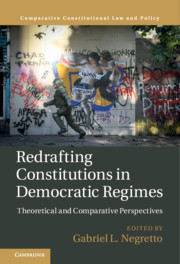Book contents
- Redrafting Constitutions in Democratic Regimes
- Comparative Constitutional Law and Policy
- Redrafting Constitutions in Democratic Regimes
- Copyright page
- Dedication
- Contents
- Tables
- Contributors
- Acknowledgments
- 1 New Constitutions in Democratic Regimes
- Part I Conceptual, Normative, and Empirical Issues
- Part II Case Studies
- 6 The Difference Power Diffusion Makes
- 7 Democratic Constitutional Replacements and Majoritarian Politics
- 8 Thailand’s Democratic Moment
- 9 Political Elites and the People
- 10 The Anatomy of Constitution Making
- Index
- References
6 - The Difference Power Diffusion Makes
Explaining Divergent Outcomes in Colombia (1990–1991) and Venezuela (1998–1999)
from Part II - Case Studies
Published online by Cambridge University Press: 29 August 2020
- Redrafting Constitutions in Democratic Regimes
- Comparative Constitutional Law and Policy
- Redrafting Constitutions in Democratic Regimes
- Copyright page
- Dedication
- Contents
- Tables
- Contributors
- Acknowledgments
- 1 New Constitutions in Democratic Regimes
- Part I Conceptual, Normative, and Empirical Issues
- Part II Case Studies
- 6 The Difference Power Diffusion Makes
- 7 Democratic Constitutional Replacements and Majoritarian Politics
- 8 Thailand’s Democratic Moment
- 9 Political Elites and the People
- 10 The Anatomy of Constitution Making
- Index
- References
Summary
This chapter compares the processes through which the constitutions of Colombia and Venezuela where rewritten during the 1990s. It argues that participatory constitutional redrafting, such as the one which took place in these two countries, generally results in constitutions that widen democracy through the introduction of novel participatory mechanisms and expansive bills of rights, allowing for the inclusion of new actors, interests and demands. However, the internal dynamics of negotiation between the drafters will determine whether the resulting text also creates institutional architectures that are favorable to competition, dissent and accountability. In cases such as Colombia, where a variety of political forces present in constitutional assemblies participate in a centripetal dynamic of negotiation and bargaining, the process often results in a consensual and balanced constitutional text that disperses power. By contrast, cases such as Venezuela, where there is a dominant force or coalition that does not need to engage in negotiations with other actors present in the assembly, tend to produce institutional arrangements that concentrate power in the executive at the expense of those institutions that place limits on the use of power thereby reducing opportunities for dissent and the possibility of accountable governments.
- Type
- Chapter
- Information
- Redrafting Constitutions in Democratic RegimesTheoretical and Comparative Perspectives, pp. 131 - 154Publisher: Cambridge University PressPrint publication year: 2020
References
- 4
- Cited by

